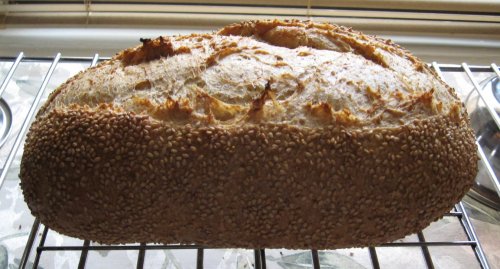
Sourdough Sesame Seed Spelt Batards
For over 3 years I've been baking artisan style breads in my (really lousy) gas oven without a baking stone but was never quite satisfied with the result. I finally purchased a good baking stone. This is my first effort with the baking stone...
Sourdough Sesame Seed Batards with Spelt Flour 
The height of each of these batards is about 4 inches (compared to the 3-1/4 inch height I got without a stone) for a similar type of dough and prebaking dough weight.
The recipe (one of my own devising) uses a white flour 100% hydration sourdough starter. About 20% of the total flour weight is spelt flour (home milled from organic spelt). In an attempt to add sesame flavor to the bread without compromising rising, I use 8% sesame seed meal, which is ground from whole sesame seeds using a small electric coffee mill. Additional sesame seeds are on the outside of the dough. Dough hydration is 68%
I am pleased with this first effort using my new baking stone, although I obviously need to become familiar with this newest addition to my bread baking equipment arsenal.
Onwards and upwards - SF
==========================
For those who are interested, this stone is a Dacor baking stone. It is 1/2 inch thick and measures 15" x 20". This was a good size for my oven, as my oven rack measures 17" x 25". I believe that smaller size baking stones from Dacor are marketed under the brand name Old Stone Oven; these smaller stones are widely available.
The stone was purchased from fantes.com for $50 USD plus shipping. The packaging was excellent and shipping was prompt.
I am including two images of this baking stone from the fantes.com site in this post to give an idea of what the baking stone looks like...




Lovely looks loaves, SF. And, that baking stone looks terrific! I couldn't live without mine.
I love the idea of using sesame seed meal. I don't have any experience with spelt yet, but plan to try it in the future after I've worked through some of the other speciality grains I already acquired.
I've purchased other things from fantes and found them to be an excellent source of baking stuff.
--Pamela
...for your kind words.
What baking stone do you own? And what brand of oven do you use?
What speciality grains do you like? And why?
This bread was a special request from a neighbor who wanted bread "with seeds" and gave me 8 oz of toasted sesame seeds for that purpose.
I wanted to add sesame seed flavor to the dough but was leary of adding a lot of whole seeds (since those could cut the gluten). I therefore came up with the idea of "milling" some of the seeds with an electric coffee grinder for a coarse meal and adding that to the dough.
Even for a dough that is largely white flour, I always like to use whole grain flour for 10 - 20% of the total flour weight. For this recipe, I didn't want the whole grain flour to mask the sesame seed flavor, so I chose spelt. White whole wheat might be a good substitute.
I am enthusiastic about having a good baking stone. I do, however, dread seeing my next utility bill.
I bought my baking stone at Sur La Table; it is made by Best Manufacturing.
When I use sesame seeds in breads (flax and pumpkin too), I soak them in water overnight first.
Yes, I have noticed that my utility bill has gone up owing to all that preheating! The bread, however, is worth the extra cost.
My oven is nothing fancy, just an ordinary run of the mill electric wall oven. I do give it a good run for its money though.
I have some semolina flour that I have yet to try. I've been baking breads that have some rye in them lately.
http://www.thefreshloaf.com/blog/xaipete
--Pamela
There is always a learning curve...

Using a baking stone is a delicate balance between the oven's capabilities and the stone. I am still learning but the bread is improving.
Here is my second bake of the identical recipe - all I did was modify the preheating time and temp and baking time and temp...
Apologies for the poor photography skills and lack of understanding of lighting. The crust of take #2 is the same golden brown as in my first attempt. However, during the bake, the dough rose through the slash considerably more than in my first attempt.
Although I love how a baking stone improves my bread, I remain nervous about my next utility bill.